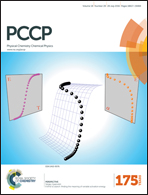Enhanced fluorescence of [[5′-(4-hydroxyphenyl)[2,2′-bithiophen]-5-yl]methylene]-propanedinitrile (NIAD-4): solvation induced micro-viscosity enhancement†
Abstract
Excited state solvation plays a very important role in modulating the emission behavior of fluorophores upon excitation. Here, the solvation effects on the local micro-environment around a fluorophore are proposed by investigating the fantastic emission behavior of a novel amyloid fibril marker, NIAD-4, in different alcoholic and aprotic solvents. In alcoholic solvents, high solvent viscosity causes an obvious enhancement of fluorescence because of the restriction of torsion of NIAD-4, where the formation of a non-fluorescent twist intramolecular charge transfer (TICT) state is suppressed. In aprotic solvents, high solvent polarity leads to a remarkable redshift of the emission spectra suggesting strong solvation. Surprisingly, an abnormal fluorescence enhancement of NIAD-4 is observed with increasing solvent polarity of the aprotic solvents, whereas solvent viscosity plays little role in influencing the fluorescence intensity. We conclude that such an abnormal phenomenon is originated from a solvation induced micro-viscosity enhancement around the fluorophore upon excitation which restricts the torsion of NIAD-4. Femtosecond transient absorption results further prove such a micro-viscosity increasing mechanism. We believe that this solvation induced micro-viscosity enhancement effect on fluorescence could widely exist for most donor–π–acceptor (D–π–A) compounds in polar solvents, which should be carefully taken into consideration when probing the micro-viscosity in polar environments, especially in complex bioenvironments.
![Graphical abstract: Enhanced fluorescence of [[5′-(4-hydroxyphenyl)[2,2′-bithiophen]-5-yl]methylene]-propanedinitrile (NIAD-4): solvation induced micro-viscosity enhancement](/en/Image/Get?imageInfo.ImageType=GA&imageInfo.ImageIdentifier.ManuscriptID=C6CP00881J&imageInfo.ImageIdentifier.Year=2016)

 Please wait while we load your content...
Please wait while we load your content...